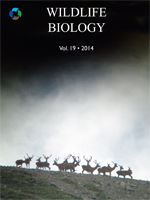In the context of remarkable increases in many deer populations observed in temperate forests, it is critical to better understand the processes sustaining abundant populations despite dramatic declines in the vegetation they feed on. When natural predation and hunting levels are too low to control deer populations, a resource-driven negative feedback is expected. Such a feedback assumes that the remaining resources do not match the energy requirements of a current herbivore population, thereby limiting herbivore abundance. Here we take advantage of a well-documented, long-term study of abundant predator-free populations of black-tailed deer Odocoileus hemionus sitkensis on the Haida Gwaii archipelago (Canada) to assess the ability of a heavily browsed forest habitat to sustain abundant deer populations. For two deer populations, we: 1) compared the energy provided by various resource pools to the energy required by deer; and 2) identified what components of the environment contributed most to support them. Qualitatively, our results are robust to the many assumptions and uncertainties and identify the resources currently available that allow these abundant deer populations to meet their energy needs despite the apparent paucity in resources. Resources are provided by a flux of hardly visible plant tissue produced by perennial species highly tolerant of herbivory and able to survive via underground structures (e.g. rhizomes), and by subsidies provided by canopy trees or by plants in refuges (i.e. litterfall and seed bank). We discuss the possibility of a resource-driven feedback that may ultimately occur in the long term as a result of changes in recruitment, productivity and fertility of plants. The possible lack of resource-driven feedback in the short or medium term should be considered by managers when assessing the need for active deer population control in situations without carnivores or hunting.
How to translate text using browser tools
1 June 2014
Understanding the paradox of deer persisting at high abundance in heavily browsed habitats
Soizic Le Saout,
Simon Chollet,
Simon Chamaillé-Jammes,
Laetitia Blanc,
Sophie Padié,
Thibault Verchere,
Anthony J. Gaston,
Michael P. Gillingham,
Olivier Gimenez,
Katherine L. Parker,
Denis Picot,
Hélène Verheyden,
Jean-Louis Martin





